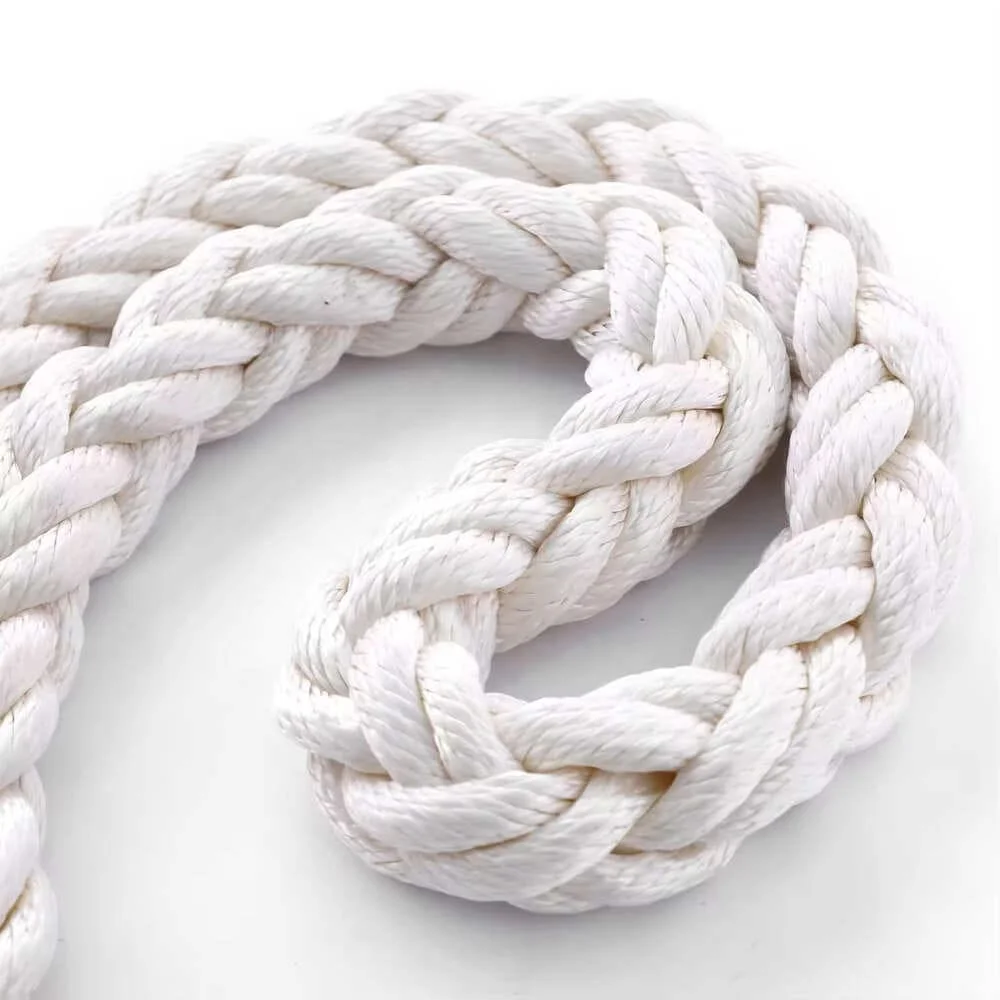Mooring Tails
View Edtech's Range Of Mooring Tails
Mooring tails, also known as synthetic tails or mooring pendants, are specialized ropes or lines used in conjunction with mooring ropes to secure a vessel to a dock or buoy. Typically made from high-strength synthetic fibers like nylon or polyester, mooring tails are designed to absorb dynamic loads and provide flexibility, reducing stress on the ship’s mooring system. They are often attached between the ship’s main mooring lines (usually made of wire) and the fixed mooring point, allowing for controlled movement in response to waves, wind, or tide. Mooring tails play a critical role in maintaining vessel stability and safety while docked, especially in ports with high traffic or challenging weather conditions.
Products
-

64 MM HIGH TENACITY POLYPROPYLENE; POLYESTER MIXED ROPE 8 STRAND LENGTH
Product successfully added to the Quote List
-

72 MM HIGH TENACITY POLYPROPYLENE; POLYESTER MIXED ROPE 8 STRAND LENGTH
Product successfully added to the Quote List
-

80 MM HIGH TENACITY POLYPROPYLENE; POLYESTER MIXED ROPE 8 STRAND LENGTH
Product successfully added to the Quote List
-

88 MM HIGH TENACITY POLYPROPYLENE; POLYESTER MIXED ROPE 8 STRAND LENGTH
Product successfully added to the Quote List
-

94 MM HIGH TENACITY POLYPROPYLENE; POLYESTER MIXED ROPE 8 STRAND LENGTH
Product successfully added to the Quote List
View Other Categories
3 Ways Mooring Tails Enhance Safety

In the maritime industry, safety is everything. Whether you’re handling cargo at a busy commercial port or managing offshore operations, the stability and security of mooring systems play a critical role in keeping vessels and crews safe.
A key but often underappreciated component of these systems is the mooring tail—a synthetic rope extension attached to mooring lines. Though small in size, mooring tails carry a huge responsibility. They offer flexibility, absorb dynamic loads, and act as a shock absorber between the vessel and its mooring setup.
When chosen carefully and maintained correctly, mooring tails greatly enhance operational safety. In this article, we’ll explore three essential safety advantages of mooring tails, and why they should never be overlooked in any mooring configuration.
Mooring lines face intense forces during everyday operations. These can come from tidal shifts, changes in wind pressure, the movement of the vessel, or the wake from passing ships.
Traditional steel wire mooring lines are strong but stiff. They do not have the elasticity to handle sudden energy spikes. When forces exceed their limits, they can snap—sometimes with deadly consequences.
This is where mooring tails step in.
Made from stretchable synthetic fibers such as nylon or polyester, mooring tails are engineered to absorb kinetic energy. They stretch under load, reducing the strain on the primary mooring line and its hardware components.
Instead of passing that sudden force directly into the ship or quay bollards, the mooring tail takes the hit. This flexibility acts like a cushion, significantly lowering the risk of equipment failure.
In practice, this energy absorption prevents dangerous line snapbacks, extends the life of mooring equipment, and ensures greater control over the vessel’s position—even in rough sea states or unexpected surges.
By softening the load, mooring tails help prevent minor shocks from escalating into major emergencies.
Beyond equipment protection, mooring tails offer direct safety benefits to the crew working near mooring stations.
When a mooring line breaks under tension, it can recoil with incredible force. This snapback effect is one of the leading causes of serious injury and fatality during mooring operations.
Because of their elasticity, mooring tails help reduce the severity of this snapback. They stretch further before breaking and dissipate energy more gradually, giving nearby personnel more reaction time and reducing impact velocity.
Additionally, high-quality mooring tails often feature color-coded wear indicators or built-in markers to indicate stress levels and usage lifespan. These visual tools help crews make fast decisions about when to inspect or retire a tail—without needing to run complex diagnostics on the spot.
Routine maintenance becomes easier and more accurate, which further minimizes the risk of using a compromised or weakened tail during critical mooring tasks.
This proactive approach to maintenance doesn’t just protect your hardware—it saves lives.
Safety drills and training programs frequently emphasize situational awareness and gear condition. Having tails with clear visual indicators supports this education and reinforces a culture of safety across the entire crew.
Mooring tails are not just a best practice—they are often mandated by international maritime safety regulations.
Organizations such as the Oil Companies International Marine Forum (OCIMF) and guidelines like MEG4 (Mooring Equipment Guidelines, 4th Edition) highlight the importance of using synthetic tails with mooring systems, particularly when using high-tension mooring lines like wire ropes.
These regulations are put in place to ensure that mooring arrangements are safe, effective, and consistent across vessels of all sizes and categories.
According to MEG4, every mooring tail must meet strict criteria related to material strength, stretch capacity, and compatibility with the vessel’s mooring winches and bollards. This includes ensuring a safe working load, proper connection hardware, and adequate rope-to-wire transitions.
Failing to comply with these standards not only increases the risk of accidents—it can lead to delays, audits, penalties, or vessel detention at port.
Using certified, high-quality mooring tails helps ensure regulatory compliance, supports risk management protocols, and improves your vessel’s operational profile. It also demonstrates to port authorities, charterers, and insurance providers that your organization is committed to best safety practices.
For companies offering maritime training through EdTech or LMS platforms, incorporating MEG4-compliant mooring systems into digital simulations and coursework is an excellent way to teach future mariners the importance of these components in real-world applications.
Small Addition, Big Impact
Mooring tails may not be the most expensive or complex part of a ship’s equipment, but their impact on safety is enormous.
From absorbing dangerous shock loads, to reducing the risk of injury, to meeting global regulatory requirements, mooring tails provide peace of mind every time a vessel is secured.
Investing in high-quality, certified mooring tails isn’t just smart—it’s essential. It protects your crew, your cargo, and your reputation.
Whether you’re a fleet manager, marine superintendent, port operator, or EdTech provider developing maritime safety content, understanding the vital role of mooring tails is key to delivering safe, compliant, and efficient marine operations.
Make the right connection. Choose safety. Choose quality mooring tails.


